by Editor | Mar 31, 2008 | Accomodations, New Articles
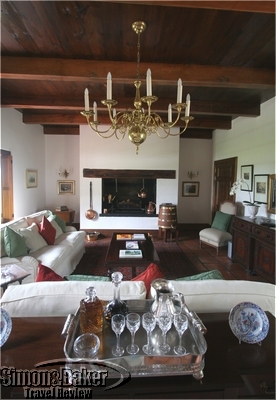
The living area of our Cape Colonial Suite
We recently revisited the Steenberg Hotel where we stayed at the Cape Colonial Suite, one of the property’s premier accommodations. In spite of the modest name, the 166 square meter $2.5 million area was more like a private one bedroom villa than a suite. One of three Heritage Suites set within the winery at the foot of the Steenberg Mountains, the Cape Colonial Suite offered the many advantages of a hotel stay plus the privacy of a villa coupled with added services and amenities.
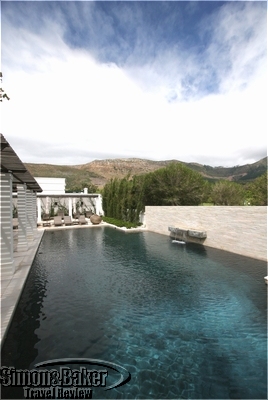
The Steenberg Hotel pool
“We find that discerning travelers are asking more often for facilities that are a ‘home away from home.’ So rather than expanding in number of suites, we felt we would serve our market better by having fewer suites that are more luxurious, spacious, and private,” said Gaby Gramm, general manager of the Steenberg Hotel.
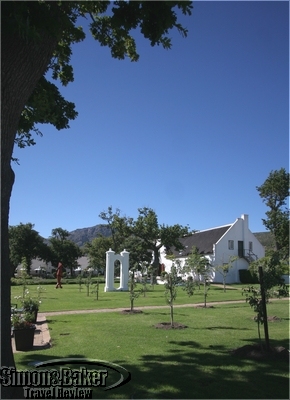
Steenberg’s manicured lawns
We enjoyed the suite’s many amenities: Entrance Lobby, air-conditioning, under floor heating, working fireplace, complimentary refreshment bar, complimentary laundry service, complimentary Wi-Fi and Internet service, personal fax and copying facilities, PC data and power outlets, extra large safe for laptops, audio entertainment system, iPod station, large work desk, original artwork, three TVs, flat screen TV in bedroom Frette and Egyptian linen, duvet, extra long and wide king bed, bathrobes, luxuriously large bathroom with separate tub, walk in shower, and professional hairdryer.
Click here to read about the Steenberg Hotel and the Cape Colonial Suite
by Editor | Mar 24, 2008 | Products

Luxury On The Go set from Silk ‘N Dreams*
Pillows and blankets on domestic flights seem to be going the way of the dinosaur. Rarely do we find pillows and when we find blankets they are are no longer wrapped in hygienic plastic. We wonder who last laid their head on the pillow and what foods were spilled on the blankets.
Recently we decided to try the shamelessly indulgent Luxury On The Go set from Silk ‘N Dreams. Designed for carry on luggage, the Luxury On The Go Set we tried retails for $95 and includes silk EyeMask, silk covered NeckPillow, pair of EarPlugs, and silky drawstring bag in the Classique pattern. Would it be worth the extra hassle of carrying them on board given the increasingly stringent carry on luggage restrictions?
A trip to Chicago provided us an opportunity to test the set and the answer was a resounding yes. The silk pillow felt soft and gentle. Used together with the eye mask they created a cocoon of comfort in the tightly filled economy section. Knowing they were clean and new was a nice feeling inviting sleep and much needed rest in spite of the cabin noises and activity. The only challenge we see for future trips is finding space in our increasingly full carry on luggage to store them. In this trip, they were worth the effort. Although they took up space in the small back pack the items combined weighed less than one pound.
Silk ‘N Dream products are made in the United States of Charmeuse Silk by a California and Florida company. According to the company website, its silk products are washable using a machine delicate cycle set in cold water with gentle soap and tumble drying on gentle cycle or line or flat dry.
* Photo courtesy of Silk ‘N Dreams

by Editor | Mar 17, 2008 | Books
By Elena del Valle
Baking and photos by Gary Cox*
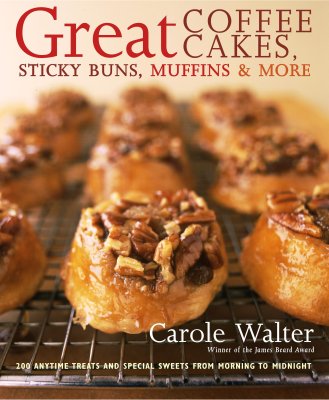
Great Coffee Cakes, Sticky Buns, Muffins & More book cover
On a recent Sunday morning, I had yummy, gooey, melt-in-your mouth miniature sticky buns for brunch at home. A week later the next batch was even better. The secret to these fabulous treats was a new book, Great Coffee Cakes, Sticky Buns, Muffins & More 200 Anytime Treats and Special Sweets from Morning to Midnight (Clarkson Potter Publishers; $35.00) by Carole Walter.
What makes the book special is the author’s vast experience, the recipes she shares and the way in which she wrote and organized the book. Great Coffee Cakes, Sticky Buns, Muffins & More is divided into chapters by topic and includes useful tips for each type of recipe. The step by step detailed instructions have the potential to inspire confidence and guide novice and veteran, professional and amateur bakers alike to produce professional quality delectable sticky buns and tasty baked goods at home.

Our miniature sticky buns right before they went in the oven
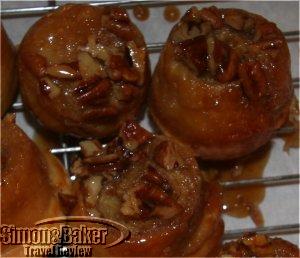
Sticky buns from the first batch Gary made
The hardcover 408-page book features recipes for pound cakes, coffee cakes, muffins, quick breads, scones, sweet biscuits, Bundt cakes, and babkas. In addition to the recipes, there are two sections of full page color photos. Part of the book’s appeal is the At-a-Glance boxes which outline baking pan sizes, oven temperatures, baking times, and any special equipment needed. Walter, a James Beard Award Winner, also shared extensive general information on outfitting home kitchens for baking, common ingredients, and techniques.

Author Carole Walter
“Baking is a wonderful activity, it’s a relaxing outlet from daily stress, a project to share with kids, it’s fun, and best of all, the rewards make everyone smile,” said Walter, a baking teacher and author, authored two baking books before this one. “When the weather is cold, there is no place I would rather be than in my warm, cozy kitchen with something delicious baking in the oven.”
Great Coffee Cakes, Sticky Buns, Muffins & More has nine chapters: Perfect Pound Cakes; Home-style Coffee Cakes; Muffins and Quick Breads; Biscuits and Scones; Easy Does It Yeasted Coffee Cakes; Brioche, Croissants and Danish; Strudel: Then and Now; Coffee Break Bites; and Streusels, Glazes, Frostings and Spreads.
Some of the recipes included: Plum-Topped Pound Cake Squares, Brown Butter Almond Cake with Stewed Fruit, Sour Cream Marble Cake, Chocolate Chip Scones, Sweet Potato Drop Biscuits, Nut Crusted Rugelach, Crumb Topped Whole Wheat Peach Muffins, Double Chocolate Walnut Babka, Apple Walnut Strudel, Holiday Stollen, and Brioche Buns with Dried Pears and Camembert.
The other recipe we tried was for Powdered Sugar Pound Cake and the results were less than stellar. The sticky buns were so delicious we think the book holds much promise and plan to keep sampling recipes.
With more than 20 years of teaching experience, Walter seems able to anticipate many of the questions that come up during the baking process. Walter has studied with renowned pastry chefs in the United States, France, Austria, Italy, and Denmark and has taught baking classes for more than twenty years at places such as Sur la Table and Williams-Sonoma. She is a Certified Professional and charter member of the International Association of Culinary Professionals (IACP) with 15 years service to culinary scholarships. She is a past president of the New York Association of Cooking Teachers, and a founding member of The Bakers Dozen East.
*Book and author photos courtesy of Clarkson Potter Publishers

Click here to buy Great Coffee Cakes, Sticky Buns, Muffins & More
by Editor | Mar 10, 2008 | Food and Wine
By Natalie MacLean

Natalie MacLean, author, Red, White and Drunk All Over
Dinner with wine used to be simple. The rule was white wine with white meat and red wine with red meat. But most of us don’t just eat meat and potatoes or drink claret and chablis these days.
With modern fusion cuisine and wines from new regions around the world, the choices – and confusion – are great. One new school of thought is that any wine goes with any dish. However, most of us don’t put ketchup on our ice cream for the same reason as we don’t drink a delicate white wine with a hearty meat dish or a powerful red wine with sole – they are mismatched flavors and textures.
When the marriage of food and wine works well, each enhances the other, making the meal greater than if you had consumed them separately. That’s why the following classic matches have survived the changes in food fashion: stilton with port, foie gras with sauternes, boeuf bourguignon with Burgundian pinot noir and goat cheese with sauvignon blanc.
It helps to start with the basic principles of food and wine pairing as they still provide a basis for experimenting with new world cuisine. One of the most important elements to harmonize between wine and food is flavor. For example, a tangy tomato-based pasta sauce requires a wine with comparable acidity. Without this balance between the acidity of the dish and the wine, the partner with lower acidity tastes flabby and dull, while the other, too tart.
To find an acidic wine, you can chose one that is made in the same area as the food. Years of matching the regional cuisine and wine as well as similar soil and climatic conditions make this a safe bet. For example, you could pair a tomato sauce fettuccine with a Tuscan chianti. Or you can select a wine from a cool climate where the grapes don’t ripen to great sweetness, and maintain their tart, tangy edge. Crisp New Zealand sauvignon blancs and French chablis serve these dishes well.
Acidic wines also work well with salty dishes. For example, oysters are both salty and briny with an oily mouth-coating texture that can smoother most wines. However, a sparkling wine from California, a Spanish cava or French champagne can both refresh and cleanse your palate when eating fish.

Bubblies also work well with spicy foods. Hot spice in Asian, Thai, curry and chili pepper dishes can numb the palate. Many of these foods also have high acidity from citrus ingredients such as lime juice as well as sweetness. Therefore, you need a wine with an acidic backbone as well as a touch of sweetness such as an off-dry California sparkling wine with lots of fruit.
While off-dry, acidic wines go well with many dishes, the two most difficult wines to pair with food are also the two most popular: chardonnay and cabernet sauvignon. New World chardonnays can be oaky, buttery, flavorful wines that overwhelm many dishes. But you can still enjoy chardonnay with your meal. Pair it with butter and cream sauces to marry similar textures and flavors.
Conversely, cabernet sauvignons can have bitter dark fruit flavours with mouth drying tannins (the same sensation you get from drinking well-brewed tea). Therefore, they find their happiest match in foods with juicy proteins such as a rare steak. The protein softens the tannin making the wine taste smooth and fruity. Steaks done with crushed black peppercorns sensitize your taste-buds, making the wine taste even more fruity and robust.
However, the way in which the dish is prepared also has an impact. A well-done steak, for example, may taste too dry with a tannic cabernet.Proteins are also at work with the marriage of wine and cheese, the cocktail classic. Red wines tend to go better with hard cheeses such as blue cheese as they can accommodate more tannins. However, whites suit soft cheeses such as brie and camembert as the creamier textures require more acidity for balance.
Game birds such quail, pheasant, turkey, duck, squab and guinea hen have earthy flavors that are more robust than chicken. Wild game often goes better with racy red wines that have a gamy quality to them, the classic being Burgundian pinot noir. The flavors of pinot noir — plum, cherry, mushrooms, earth and even barnyard (that’s a positive adjective) – accentuate the same gamy flavors in the food. Other wine options for game birds include Spanish rioja, Oregon pinot noir and lighter-style Rhône Valley wines such as Côte-Rôtie.
One of the most challenging flavors to balance is sweetness. Dishes with a touch of sweetness such as glazed pork do well with off-dry wines such as riesling and chenin blanc. However, rich desserts such as chocolate and crème brulée demand a wine that is sweeter than the dessert, or the wine will taste thin, even bitter. Sweet wines such as sauternes, Canadian icewine, late harvest wines and port will work not only for their sweetness but also for their unctuous texture.
Your best source of food and wine matching is your own palate. Experiment with different combinations to discover not only what makes a perfect pairing for you, but also to broaden your range of possibilities. As the author Alexis Lichine observed, “There is no substitute for pulling corks.”
This article is reprinted with permission from Natalie MacLean’s free e-newsletter. Natalie MacLean is the author of Red, White and Drunk All Over: A Wine-Soaked Journey from Grape to Glass. She was named the World’s Best Drink Writer for the articles and wine picks in her free wine newsletter available at http://www.nataliemaclean.com/.
by Editor | Mar 3, 2008 | Restaurants and Food
Photos and article by Josette King, in cooperation with Lee Fuller, oenophile and wine collector
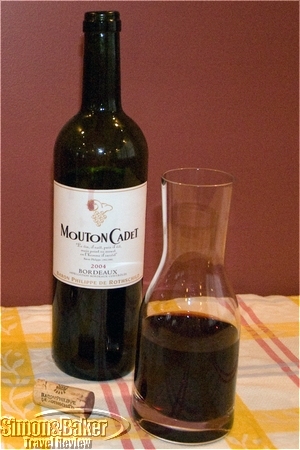
Baron Philippe de Rothschild, Mouton Cadet, Bordeaux 2004
A few years ago, as we were planning our family Thanksgiving dinner, my wine enthusiast son Lee Fuller declared himself unwilling to serve the usual obvious whites with the traditional turkey. He volunteered to lead the reform by arranging a tasting, a few days prior to the gathering, of five moderately priced wines to vie for an appearance on our holiday table. During the event, we first tasted (and expectorated) each wine on its own and later sampled each one in turn with tiny portions of food. A lively evening of discussion followed and a holiday tradition was born!
Our most recent tasting took place a few days before Christmas. I was entrusted with the choice of wines. Mine was an impulsive selection of French wines, guided more by memories of my Paris youth than considerations of what would best compliment our Christmas Eve raclette or the roasted leg of lamb and Bûche de Noël on our Christmas Day menu.

I adhered to our basic tenet: five wines, moderately priced (under $25). I chose one sparkling wine, one white, two reds and a sweet red dessert wine: Lucien Albrecht Crémant d’Alsace Brut Rosé, Domaine Fournier Sancerre Sauvignon Blanc 2005, Marc Kreydenweiss Domaine des Perrières Costières de Nîmes 2003, Baron Philippe de Rothschild Mouton Cadet 2004, and M. Chapoutier Banyuls Grenache Noir 2004. Here are our findings:
Lucien Albrecht, Crémant d’Alsace Brut Rosé (sparkling – non-vintage)
Approximate retail price: $19.99
Since we especially enjoy brut sparkling wines as an aperitif, we started with a Crémant d’Alsace Brut Rosé, non-vintage, from Lucien Albrecht (crémant is the official appellation that designates French sparkling wines produced outside the Champagne region). With its tiny bubbles and lovely peach color, this luscious sparkler looked and tasted much more expensive that it actually was!
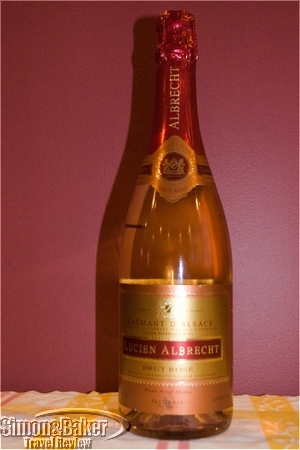
Lucien Albrecht, Crémant d’Alsace Brut Rosé
Made from 100 percent pinot noir, its aroma was dominated by red berries with a hint of rose petal. On the palate, it generously released raspberry, strawberry and red currant flavors. We unanimously loved this crisp and elegant wine as a starter to our evening, alone and with light hors d’oeuvres. One minor caveat: we tried it again at the end of the evening and found that it didn’t stand up well to our chocolate dessert.
Domaine Fournier, Sancerre, Sauvignon Blanc 2005
Approximate retail price: $19.99
I have always been fond of Loire Valley whites, especially Sancerre. Therefore, this was an easy selection, since Domaine Fournier is known as one of the most important estates in the Sancerre region. Made of 100 percent sauvignon blanc grapes, this lively, pale 2005 Sancerre opened with a pleasant citrus aroma that developed on the palate as a lemon and grapefruit taste with undertones of green apple. Its dry, clean finish lingered nicely.
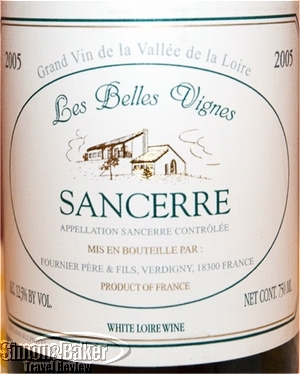
Domaine Fournier, Sancerre, Sauvignon Blanc 2005
We unanimously declared it an excellent aperitif candidate. We also enjoyed it with fresh goat cheese, and with seafood. Later that week, we found it went well with pasta in a cream and herb sauce. This is another refreshing, fruity wine that I will definitely enjoy serving throughout the year!
Marc Kreydenweiss, Domaine des Perrières, Costières de Nîmes 2003
Approximate retail price: $13
I was intrigued by this wine because of its biodynamic status. Biodynamism is a combination of organic winemaking and sustainable agriculture that adopts the use of organic fertilizers, the elimination of chemical pesticides and herbicides, and other health-conscious practices for the protection of the ecosystem. In Alsace, the Kreydenweiss estate has been in existence for over three and a half centuries. The current owner Marc Kreydenwiess completed the conversion of the entire estate to biodynamic culture in 1990. He applied the same principles to his Domaine des Perrières as soon as he purchased it in 1999.
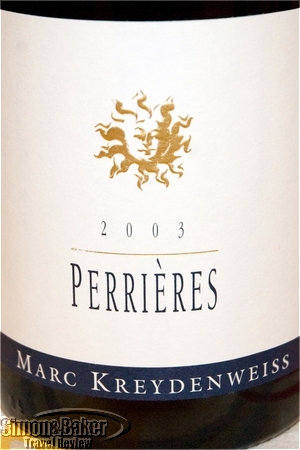
Marc Kreydenweiss, Domaine des Perrières, Costières de Nîmes 2003
The 2003 Perrières we sampled was an earthy red Rhone blend of cardigan, grenache and syrah, deep ruby in color, with an aroma of red fruit, spices and a hint of oak. The palate was a bit tart for a red, spicy and somewhat tannic. I detected a touch of licorice in the finish, an issue for me as I dislike that taste. However, Lee our experienced oenophile immediately identified the mellow presence of grenache and a hint of vanilla. He declared the 2003 Costières de Nîmes, Domaine des Perrières a good candidate for summer drinking on its own, with cob salad or grilled meat. N.B.: We decanted this red 30 minutes before tasting.
Baron Philippe de Rothschild, Mouton Cadet, Bordeaux 2004
Approximate retail price: $8.99
In my younger decades, the Rothschild Mouton Cadet was my reliable red stock Bordeaux. This broad distribution wine from France had the advantage of being always available, of predictable quality and affordable. I couldn’t remember when I drank it last, so I decided to give it another try. As we uncorked it I detected a faint musty smell to it. However, after we decanted it for 30 minutes it opened up to reveal a pleasing earthiness and a flavor of dark berries with notes of cassis. This blend of 65 percent merlot, 20 percent cabernet sauvignon and 15 percent cabernet franc was deep red in color, with just enough authority that we knew we were drinking red wine. Yet it was simple enough that it transferred well between different appetizers. It also worked successfully with a cheese tray but did not hold up to red meat. We will keep in mind for large casual gatherings.
M. Chapoutier, Banyuls, Grenache Noir 2004
Approximate retail price: $25 for a 50cl bottle.
To me, Banyuls will forever evoke childhood memories of a small vacation town on the western Mediterranean coast, where France touches Spain, with the foothills of the Pyrenees as a backdrop; and the rich, sweet, dark wine of the same name. I remembered it as a Port-like nectar ubiquitously served as an aperitif and dessert wine.
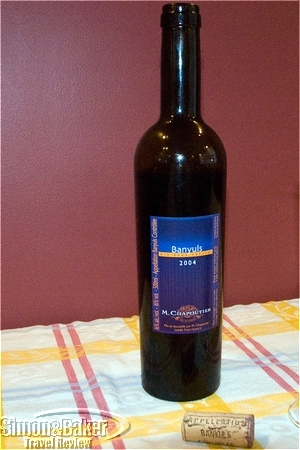
M. Chapoutier, Banyuls, Grenache Noir 2004
We tasted the Chapoutier Banyuls Grenache Noir 2004 at dessert time. Made of 100 percent grenache noir, it was deep garnet in color, with aromas of dried fruit and candied citrus. The palate was creamy and sweet, with rich undertones of cherries and chocolate. We enjoyed it on successive occasions with Roquefort cheese and chocolate desserts, as well as on its own for after-dinner sipping.
While our original tasting intent was to focus on wines for our holiday table, we are delighted to have discovered an assortment of wines we will enjoy on multiple occasions throughout the year.
























